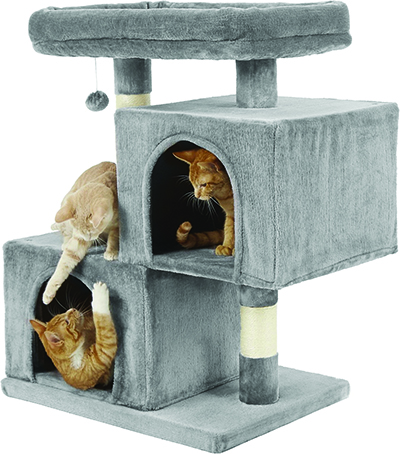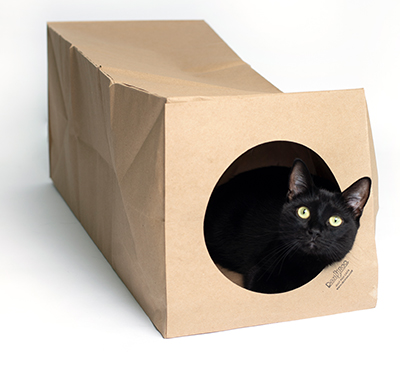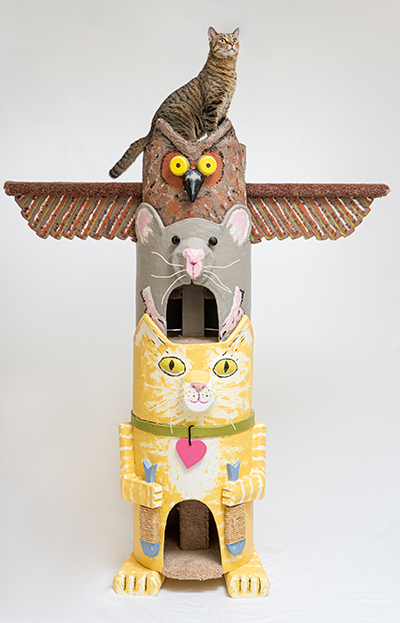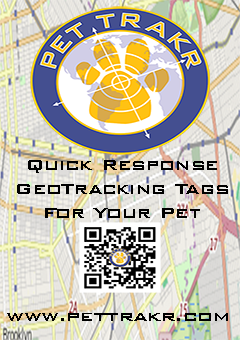Kitty Hideaways
Why Cats Need to Hide!
By Monie Schulling
Your kitty having a safe hiding place is very pawsitive! Dr. Lynn Bahr, feline veterinarian and founder of Dezi & Roo (deziroo.com), stresses the importance of allowing cats to hide as it keeps their minds and bodies active, as she explains, “cat owners need to understand the importance of providing hiding places as a means of adding environmental enrichment into the lives of indoor cats. Hiding is fun for cats! They can hide from their cat parents, play hide and seek, and burrow away into a comfortable, dark, cozy, well- protected spot to get some good deep sleep.”

- Hiding helps cats cope with noise, commotion, people, strangers, and other stressful situations.
- Fearful cats almost always look for places to hide. The cat that feels backed in a corner without any choice is the cat that lashes out or bites. Hiding offers cats the opportunity to retreat rather than attack.
- Sick cats prefer dark, quiet hiding places where they feel less vulnerable to threats and can take time to heal undisturbed. Cats who are not feeling well often hide in order to conserve energy or avoid pain.
- Feeling safe hiding allows cats to sleep more deeply, which is good for their health.
I’ve seen frantic posts in lost pet groups where owners are sure their cats somehow got out only to get an update hours later they were found…in the house! The owners organized a neighborhood search party, looked in sheds, garages, trees, searched inside and outside and found no kitty. They had even gone so far as to put the litter box outside plus smelly food. Giving up for the night, exhausted and discouraged, owners walk into their house and there was a well-rested Bootsie meowing loudly in the kitchen because they are late feeding him! Of course; Bootsie is not giving up where he was hiding for the last five hours! Before Bootsie gets lost again, be sure to set up several hiding spots for your cat.

Hunter and Hunted
Cats are hunters and survive in the wild by eating birds, rabbits and mice. Cats are also the hunted by larger animals such as coyotes, wolves, hawks and eagles. Cats instinctively want to find a safe hiding space and get up high where bigger animals cannot ascend so they can sleep their 16-22 hours day safely. Coyotes continue to hunt further into urban areas as we build in their habitats. They prey on our small companion animals in the back yards so please keep your kitties indoors for their safety. I work with several rescues helping to save strays. Just as soon as we find the mom’s hiding place for the kittens she moves them. Stray or Feral moms are very adept at hiding kittens from predators.

Multi-Cat Dynamic
Even with a loving dynamic between your cats where they cuddle together in the sun or otherwise hang out in harmony, they still need their own individual space they can mark with their scent and relax. If there is a conflict or tension between your animals, it’s essential to maintain serenity by giving each cat a space they can call their own. Cats mark their scents by scratching with their paws and rubbing items with the scent glands on their face. They want soft, warm beds and they want to smell their own scent for comfort. For a more submissive cat; less stress often means being able to get up high where the more aggressive cat (or dog) cannot reach them. Hiding spaces such as a box, a cat tree with a house or a tunnel will also make them feel secure. Dezi & Roo addresses this need with The Hide and Sneak Unique Cat Toy Tunnel has a cardboard opening front and back is the perfect place to hide for a new kitty. Plus they can mark their scent on it too. And It’s big enough to put their food in making it a great multi-purpose toy.

New Cats or Kittens
Per Dr. Lynn Bahr, DVM, “First impressions count!” How you introduce cats into your home and to existing pets can make or break the relationship. When you bring a new kitty home for the first time; start them off in a smaller space with a hiding spot so they are not fearful of the new environment. Fearful kitties will hiss, swipe and bite. Newly arrived kitties are in a strange place, with new people and possibly the scents of other cats and dogs. They need time to get used to you and the environment. You will have the most success in integrating a new cat to your family and existing pets if you go at their pace.
Change in Hiding Behavior
If your cat seems out of sorts and is hiding more than normal, is not eating or has a change in behavior; it is wise to enlist the help of a Veterinarian to ensure your kitty is not ill or under considerable stress. Any change in environment; a new home, new cat, new dog, new baby, new partner, neighbors with barking dogs, illness, age, and many other factors can cause a change in hiding behavior. Be aware of your kitty’s typical conduct and seek help from your Veterinarian if anything changes.
and Climbing Towers your Cats will Love!
According to Architect Mario Arbore the designer behind Squarepaws.com which sells fantastic custom, made-to-order cat towers, “When designing for cats that like to hide, it’s always important to provide for a minimum space of a 13-inch diameter circle. This gives the cat enough room to curl up in a ball. It’s also good for the cat to have two exits from that ‘cave’ space, and to allow the kitty to see out of the cave. In a multi-pet household, sometimes there can be competition for that space, especially if there are multiple cats. It’s good for them to feel they can escape if a fight breaks out. Also, having a hiding space that’s elevated is important for cats. They can retreat from a dog or cat in the home and sleep peacefully.”











